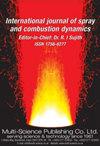Multiple structures and transition mechanisms of laminar fuel-rich ethanol/air counterflowing spray flames
IF 2.1
4区 工程技术
Q3 ENGINEERING, MECHANICAL
International Journal of Spray and Combustion Dynamics
Pub Date : 2023-08-23
DOI:10.1177/17568277231193331
引用次数: 0
Abstract
Structures of laminar non-premixed ethanol/air spray flames in the axisymmetric counterflow configuration are studied under fuel-rich conditions by means of numerical simulations. The monodisperse ethanol spray is carried by air and directed against an air stream. Both streams enter at 300 K, and the system is at atmospheric pressure. Up to three different structures of these flames for identical boundary and initial conditions are identified, and regime diagrams are presented that show their conditions of existence in terms of the gas strain rate on the spray side of the configuration, [Formula: see text], starting from 55/s at an initial spray velocity of 0.44 m/s. The equivalence ratio on the spray side, [Formula: see text], is varied between 1.1 and 1.6, and initial droplet radii, [Formula: see text], from 10 to 50 [Formula: see text]m are considered. The most stable spray flame structure is characterized by two chemical reaction zones. For some conditions, single chemical reaction zones on either side of the counterflow configuration are found. Conditions under which these different flame structures exist are analyzed. Previous studies identified only two different structures for non-identical boundary conditions, and in this study, three different structures are presented for the first time. Moreover, the transition mechanisms of one structure to another are analyzed. The competition between the energy-consuming spray evaporation and the exothermic chemical reaction rates as well as the location of the spray determines the existence of the different flame structures. This transition of the different flame structures may explain spray flame characteristics such as flame pulsation or flame instabilities.层流富燃料乙醇/空气逆流喷雾火焰的多重结构和过渡机制
采用数值模拟的方法,研究了富燃料条件下非预混乙醇/空气层流喷射火焰在轴对称逆流状态下的结构。单分散乙醇喷雾由空气携带,并直接对着气流。两股气流在300k时进入,系统处于大气压力下。在相同的边界和初始条件下,识别出多达三种不同结构的火焰,并给出了状态图,显示了它们在配置的喷雾侧的气体应变率方面的存在条件,[公式:见文本],从55/s开始,初始喷雾速度为0.44 m/s。考虑喷雾侧等效比[公式:见文]在1.1 ~ 1.6之间变化,初始液滴半径[公式:见文]在10 ~ 50[公式:见文]m之间变化。最稳定的喷焰结构以两个化学反应区为特征。在某些条件下,逆流构型的两侧存在单一化学反应区。分析了这些不同火焰结构存在的条件。以往的研究只确定了两种不同的边界条件下的结构,而在本研究中,首次提出了三种不同的结构。此外,还分析了一种结构向另一种结构的过渡机制。消耗能量的喷雾蒸发与放热化学反应速率之间的竞争以及喷雾的位置决定了不同火焰结构的存在。这种不同火焰结构的转变可以解释喷雾火焰的特征,如火焰脉动或火焰不稳定性。
本文章由计算机程序翻译,如有差异,请以英文原文为准。
求助全文
约1分钟内获得全文
求助全文
来源期刊

International Journal of Spray and Combustion Dynamics
THERMODYNAMICS-ENGINEERING, MECHANICAL
CiteScore
2.20
自引率
12.50%
发文量
21
审稿时长
>12 weeks
期刊介绍:
International Journal of Spray and Combustion Dynamics is a peer-reviewed open access journal on fundamental and applied research in combustion and spray dynamics. Fundamental topics include advances in understanding unsteady combustion, combustion instability and noise, flame-acoustic interaction and its active and passive control, duct acoustics...
 求助内容:
求助内容: 应助结果提醒方式:
应助结果提醒方式:


